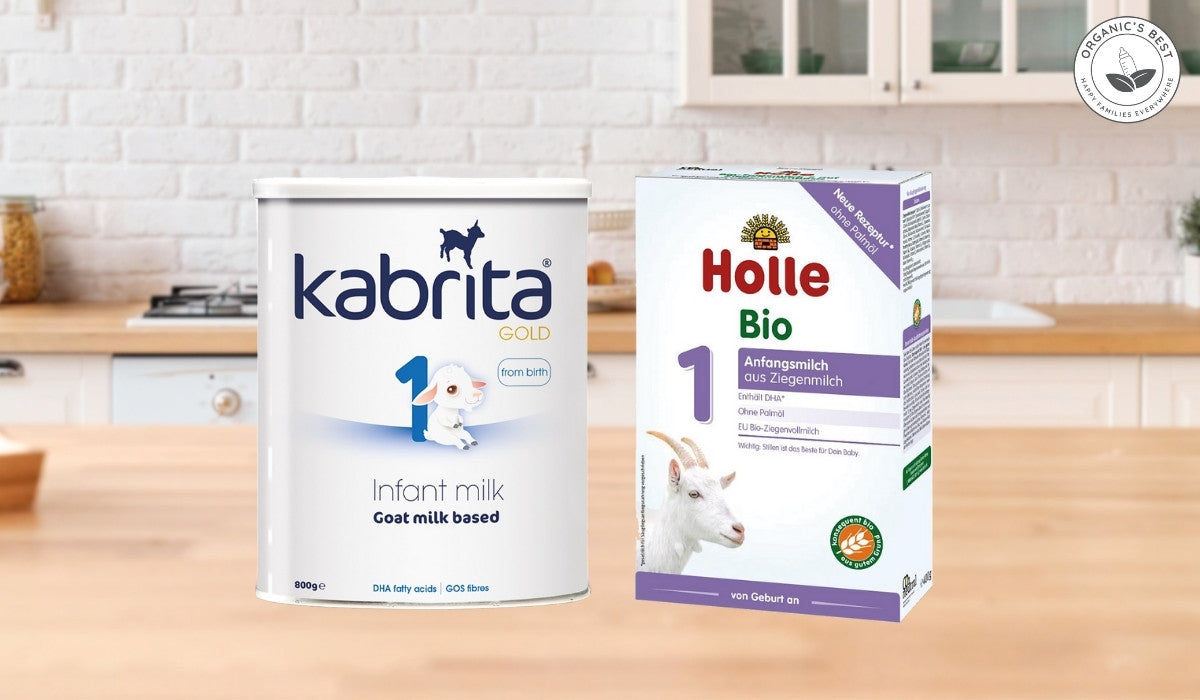Click to Get 2 FREE Boxes/Cans
Click to Get 2 FREE Boxes/Cans
Only New Customers! Click HERE to Get 2 Extra Boxes/Cans for Free With Your First Order.
Only New Customers! Click HERE to Get 2 Extra Boxes/Cans for Free With Your First Order.
BABY FORMULA
Offering new parents top-quality European infant formula from renowned brands like HiPP, Holle, Kendamil, and more. If you’re uncertain about which product to choose, our Formula Finder can help you make the best decision for your baby.
Baby Food
Offering new parents a premium selection of European baby foods, including jars, pouches, cereals, and snacks from esteemed brands like HiPP and Holle.
Kabrita vs. Holle
by Agustina Fernandez April 14, 2021 12 min read

Welcome to our detailed comparison of Kabrita and Holle formula!
If you are reading this article, you most likely have made the decision to go with a goat milk formula. That's great! Goat milk baby formula is highly nutritious and has some great features that your little one can benefit from.
Probably the biggest advantage of goat formula is that it's easily digestible. It can sometimes be a good option for babies with mild issues digesting cow's milk (but not for babies with a suspected or diagnosed cow's milk allergy or severe lactose intolerance). Additionally, it contains fewer allergens than cow's milk formula. And there are some amazing brands out there that produce goat milk formula!
If you are looking for more information on the differences between goat and cow formula, we have an article that compares them in detail: From preparation, consistency and taste to nutritional value and digestion.
Now, cow milk formula is usually the standard. Most parents in Western countries (especially the US and Canada) opt for cow's milk formula. It's the most trusted and by far the most widely used and sold. But goat milk is becoming increasingly popular.
Especially the interest and demand for high-quality European goat milk formulas, such as Kabrita from the UK and Holle from Germany. Goat milk formula has been proven to be a safe and healthy alternative to cow's milk formula. Many parents nowadays (and for a long time in other cultures) count on goat formula for their baby.
Before you read on, we would like to point out that breastmilk is always best for your baby. It contains the perfect balance of nutrients that babies need for growth and development.
However, it is not always possible for all mothers to breastfeed their babies. For this reason, much research has gone into creating formulas with nutrient profiles that are as close as possible to that of breastmilk. Two of those will be introduced and discussed in this article.
Remember to speak with your pediatrician before using or changing to a particular formula.
Table of contents

Introducing Holle Organic Formula
Holle offers a wide variety of organic food products for babies, ranging from infant formula to milk cereals and baby porridges, among others. In this article, in the spirit of keeping it short and to the point, only the baby formula will be discussed.
Holle offers three types of organic infant formulas:
- Baby formula made from Demeter quality cow’s milk (Holle Cow)
- Baby formula made from EU-organic certified goat's milk (Holle Goat)
- Baby formula made form EU-organic A2 cow's milk (Holle A2)
Check out our guide to learn more: Holle Cow vs Goat Formula Comparison
These formulas are very popular in Europe and all over the world. Parents love that Holle formulas are organic, which means that the products contain no GMOs, and ingredients come from organic farming that prohibits the use of hormones, pesticides, and other potentially harmful substances.
The main ingredients used in making the formulas are sourced from Europe. Additionally, they produce CO2 neutrally! Holle formulas are also labeled as gluten-free, egg-free, and unsweetened.
Holle formulas come in different stages according to your baby’s development. The cow formula comes in 5 stages (Pre, 1, 2, 3, 4), whereas Holle Goat comes in 3 stages:
- Stage 1 is an infant formula that is appropriate from birth.
- Stage 2 is a follow-on formula that should be used only after the 6th month. It is perfectly adjusted in nutrient composition for the age of starting to feed solid foods.
- Stage 3 is a follow-on formula that is perfectly adjusted for babies of 10 months and older who are already eating balanced meals of solids.
Learn more: European Baby Formula Stages Guide

Holle Cow Milk-Based Formula
In this article, our focus is on comparing Holle goat milk infant formula and Kabrita formula. However, before then, it is only prudent to mention a few things concerning Holle cow milk formula.
Holle Cow formula comes in 5 different stages, ranging from pre to stage 4. All cow milk formulas by Holle have the Demeter organic certification. This is one of the strictest organic labels in the world and has regulations that go above and beyond the EU Organic certification.
Holle also offers 3 stages with organic A2 milk. This wide range of products gives you plenty of options to choose from that best suit your baby’s needs. Be sure to consult your pediatrician first when deciding which formula to choose for your child!
All these formulas contain organic vegetable oils, fish oils, and other vitamins and minerals that the baby needs. There are follow-on formulas with the same features, so that you can be consistent in giving your child the same brand as they develop.
The composition of the Holle cow milk-based formula is slightly different from Holle goat milk formula in that the cow's milk formula contains palm oil and the goat milk formula does not. Additionally, Holle Cow formula uses DHA derived from fish oil, whereas Holle Goat formula contains DHA from algae oil.

Introducing Kabrita Infant Formula
Unlike Holle, Kabrita offers only goat milk-based formulas. There are various products, including infant formula, follow-on milk, and toddler milk, all made from goat milk.
- The infant formula is for babies from birth to 6 months.
- The follow-on milk is for babies between 6 and 12 months of age.
- Finally, the Kabrita toddler milk is for babies who are older than 12 months.
Kabrita infant formula is not organic. However, the formula is free from GMOs, and the company adheres to animal-welfare regulations.

Why are There Age limits for Different Types of Formula?
If you are wondering why you should adhere to the stages for European baby formulas, here is why.
Infant, follow-on, and toddler formulas vary in nutritional content and ingredients. The digestive systems of infants are not able to handle formula meant for toddlers. On the other hand, due to the difference in nutritional content, infant formula cannot meet the nutritional needs of toddlers.
Proper nutrition is essential for the optimum development of your baby. For this reason, you must ensure that your baby gets the right quality and quantity of essential nutrients at their given age. That's why it is essential only to feed your little one a formula that is intended for their age.
Major Differences Between Holle and Kabrita Baby Formula
In order to make an in-depth comparison between the two types of formula, this article will focus mainly on Holle Organic Goat Milk Formula (which will also be referred to as Holle Infant Formula) and Kabrita Infant Formula (Kabrita Formula).
Organic vs Non-Organic
Holle baby formula is certified EU organic, whereas Kabrita is not USDA organic. This is an important factor to consider since a non-organic formula may contain some unwanted ingredients that are absent in an organic formula.
Even though Kabrita baby formula is non-organic, it is still safe for your baby. Kabrita formula is GMO-free, and it is produced in adherence to strict regulations. However, if you have a preference for organic goat milk formula, then the Holle baby formula may be a better fit.
What is the Difference Between Organic and Non-Organic Formula?
The EU organic regulations contain strict rules to mitigate the risk of harmful substances entering the product through the farming process. Conventional fertilizers and pesticides are not used, and as for animals, the use of hormones is prohibited, and antibiotics are only allowed if medically necessary for animal health.
Organic formula is GMO-free and does not contain artificial preservatives, flavors, and other additives. The additives in the organic formula must adhere to the National List of Allowed and Prohibited Substances.
Additionally, the producers must adhere to rules for animal welfare and limit their environmental impact. Beyond that, EU organic also means that in production, preparation, and distribution, strict regulations must be followed. The adherence to all regulations is ensured through a strict system of control and enforcement.
For infant formula to be labeled EU organic, 95% of its ingredients must be sourced from farms that are EU organic-certified.
Non-organic formula, on the other hand, might contain some additives, sweeteners, and preservatives. Despite this, it is important to note that a non-organic formula is also safe for your child. Some formulas like Kabrita are not organic, but they are GMO-free, are tested for heavy metals, and are made with strict adherence to regulations that limit the use of hormones, antibiotics, and pesticides.
When making your choice, it is advisable that you check the list of ingredients on both types of formula and choose the one that meets the specific needs of your child. Good formulas should aim to resemble the nutritional profile of breast milk. Do not forget to consult your doctor before settling on a specific type of formula!
Cow’s Milk vs Goat Milk
Kabrita only offers formulas made from goat milk. Therefore, if you are looking for cow's milk formula, then you should consider choosing Holle. However, if you are looking for a goat milk-based formula, you can choose from either Kabrita or Holle, in which case you will have to consider other factors.
At this point, it is important to mention that goat milk is not a suitable alternative to cow's milk formula for babies who are allergic to cow's milk. It is also not advisable for babies who are lactose intolerant. It is a common misconception that goat milk formula is safe for babies who are sensitive to cow’s milk formula.
If your baby is allergic or intolerant to cow’s milk formula, they are likely to react the same way to goat milk formula. The protein that causes the allergic reaction to cow's milk is also present in goat milk, and even though it is lower in goat milk, there is still a chance that it would trigger an allergic reaction.
Whole vs Skimmed Milk
Holle Organic goat milk formula is made using whole goat milk powder, whereas Kabrita Infant Formula is made from skimmed goat milk. The main difference between skimmed and whole milk is the fat content.
Whole milk contains about 3.5% milkfat by weight, whereas skimmed milk contains less than 0.5% milkfat. Skimmed milk is produced by removing fat from whole milk. Despite the differences in fat content, the protein content in both skimmed and whole milk is the same.
The difference in the fat content has a number of implications for the nutritional value of the milk with respect to vitamin D and omega-3. Vitamin D is a fat-soluble vitamin. Therefore, it is naturally found in fat in the milk, so generally, the less fat there is, the less vitamin D content there is in the milk.
However, formulas are fortified with the appropriate amount of vitamin D that babies need to remedy this issue. But of course, it's always nice if the formula relies on as many nutrients as possible that are naturally found in the milk rather than being fortified with those nutrients.
Whole milk has more omega-3 fatty acids than skim milk. Omega-3 has incredible health benefits, and therefore, it is worth careful consideration. Of course, omega-3 is being fortified in appropriate amounts in both formulas as it is required by law. However, it is worth considering that whole milk powder has more natural omega-3 and thus requires less fortification.
Sources of Vegetable Oils
Vegetable oils are used in infant formula to enable the formula to match the fatty acid profile of human milk. Some of the most common oils that are used in baby formula ingredients are palm olein oil, soy oil, coconut oil, high oleic sunflower oil, and high oleic safflower oil, in various combinations.
When it comes to vegetable oils used in the formula, Holle Goat contains a blend of sunflower and rapeseed oil.
Kabrita has a larger blend of oils. This blend consists of high sn-2 palmitic acid oil, soybean oil, palm kernel oil, and sunflower oil. The palm oil in Kabrita is modified in such a way that it has no negative effects, like forming calcium soaps. However, it is not organic or sustainably sourced. Some parents may have ethical concerns about purchasing products that have non-organic palm oil.
Further, some parents do not love the idea of soybean oil in their little one's formula. They soybean oil in Kabrita is guaranteed GMO-free, and it is important to note that the potential negative health effects of soy for babies relate to soy protein (meaning soy-based baby formula), they do not apply to soy as a source of oil.
SN-2 Palmitic Acid Oil Composition
Kabrita Infant Formula contains high palmitic acid. This palmitic acid is usually found in human milk and is responsible for favorably influencing the absorption of fatty acids, calcium, bone matrix, and the general health of the gut microbiome. The palmitic acid in Kabrita infant formula is derived from vegetable oils.
While Holle infant formula is not indicated as containing high palmitic acid, the fact that it's made from whole goat milk that's high in dairy fat may help to supply adequate amounts of palmitic acid. Studies have shown that formulas that contain dairy fat tend to have more palmitic acid esterified in the sn2 position.
Furthermore, recent research shows that the best way to mimic human breast milk oils is by blending dairy fat with vegetable oils (like Holle does). This is in opposition to the recent trends where milk fat is removed and replaced with vegetable oil (like in Kabrita).

DHA Sources
Docosahexaenoic acid (DHA) is an omega-3 fatty acid that is present in human milk and can also be obtained from fish oil or algae oil. DHA has immense health benefits, but the main benefits of DHA are that it boosts brain development and eye health, and improves the functioning of the heart. For this reason, DHA is added to baby formulas in the EU as a matter of legal requirement.
Holle organic goat milk formula contains DHA obtained from algae oil. This means that the DHA is sourced from algae. Kabrita Toddler formula, on the other hand, contains DHA from fish oil. Studies show that the quality of omega 3 found in algal oil is the same as that found in fish oil. Therefore, you are at liberty to choose either formula for your baby. Some parents may prefer that the source of DHA in Holle Goat milk formula is plant-based.

Iron Sulfate vs Iron Lactate
Iron is needed by the human body to make hemoglobin. Hemoglobin is the protein that carries oxygen in the red blood cells to other parts of the body and carries carbon dioxide from other parts of the body to the lungs. Iron is particularly important for infants and young children as it supports proper neurological development. Although cow milk has about the same amount of iron as human milk, it is not absorbed well by the body. For this reason, infant formula is often fortified with iron.
Kabrita Toddler Formula is fortified with iron sulfate, while Holle goat milk formula contains iron lactate as the source of iron. While both of the iron salts are freely water-soluble and are good sources of iron, some studies have shown that iron absorption is higher from iron sulfate than from iron lactate.
Important Notes on Formula Feeding
- Always consult your pediatrician or nutritionist before settling on a particular formula or before switching to another. This is crucial because each baby is unique, and whatever works for one baby might not work for another.
- Most importantly, goat milk formula is not the appropriate alternative for children who are allergic to cow’s milk protein or those with severe lactose intolerance.
- Whenever possible, breast milk is the best source of nutrition for your baby, and you can supplement with formula.
- Always follow the instructions on the tin. You should only deviate from these instructions if your doctor advises otherwise.
- For you to get the best experience from any formula, it is important to observe proper hygiene when handling baby food. Furthermore, proper storage of any formula is important to preserve the product.
Conclusion
Both Holle and Kabrita infant formulas are safe options for most healthy babies. Due to strict European regulations for baby formulas and their ingredients, there are only slight differences between the two. Some of the main differences are:
- Holle infant formula is made from organic goat milk while Kabrita formula is non-organic
- Holle infant formula is made using whole milk powder whereas Kabrita formula is made from skimmed milk powder
- Kabrita formula contains a fat blend that includes modified palm oil and soybean oil, whereas Holle contains a blend of only sunflower and rapeseed oil.
- The DHA in Holle formula is sourced from algal oil while that in Kabrita is sourced from fish oil.
In general, both formulas have great nutritional profiles. They both contain the major vitamins, proteins, carbohydrates, oils, and minerals that are required for the growth and development of babies. Most importantly, both Kabrita and Holle formulas contain all important nutrients that your baby requires to grow up healthy, including DHA. As mentioned before in this article, DHA is essential for the development of babies, and formula manufacturers are required to include it in all infant formula.
The choice between the two will depend on the personal preferences of the parents and the individual needs of their children. For instance, some parents tend to prefer formula that is certified organic over the standard non organic formulas, which allows them to have a better conscience about the ingredients (95% of which are sourced from organic farms that are committed to animal welfare and more sustainable farming practices).
Additionally, consumers may trust the quality of organic ingredients more because the EU has strict standards in place for limiting the use of artificial fertilizers, herbicides, and pesticides, and for animals they only allow antibiotics to be used when medically necessary while prohibiting the use of hormones.

More Helpful Formula Guides!
References
1. Fabiana Bar-Yoseph, Yael Lifshitz, Tzafra Cohen, Review of sn-2 palmitate oil implications for infant health, Prostaglandins, Leukotrienes and Essential Fatty Acids, Volume 89, Issue 4, 2013, Pages 139-143, ISSN 0952-3278
2. Sherry M. Lewis, Duane E. Ullrey, Dennis E. Barnard, Joseph J. Knapka, Chapter 9 - Nutrition, In American College of Laboratory Animal Medicine, The Laboratory Rat (Second Edition), Academic Press, 2006, Pages 219-301, ISBN 9780120749034
3. Souza, C.O., Leite, M.E.Q., Lasekan, J. et al. Milk protein-based formulas containing different oils affect fatty acids balance in term infants: A randomized blinded crossover clinical trial. Lipids Health Dis 16, 78 (2017).
4. Infant Formula Containing Full Cream Milk Fats: Latest Innovations;
|
Disclaimer: Please be aware that this information is based on general trends in babies, and it is not medical advice. Your doctor should be your first source of information and advice when considering any changes to your child’s formula and when choosing your child’s formula. Always consult your pediatrician before making any decisions about your child’s diet or if you notice any changes in your child. Breastfeeding is the best nutrition for your baby because breast milk provides your child with all the essential nutrients they need for growth and development. Please consult your pediatrician if your child requires supplemental feeding. |
Agustina Fernandez
Dr. Agustina Fernandez earned her medical degree from the prestigious Universidad Nacional de Córdoba, Argentina. With a deep-rooted passion for pediatrics, Dr. Fernandez is currently on the path to specializing in children's healthcare. Recently, she has delved into the vital field of infant nutrition. Her research interests include breastfeeding, infant formula, and baby food in little ones’ formative years. Dr. Fernandez's commitment to this area of study underscores her dedication to ensuring the health and well-being of children from their earliest days.
1 Response
Leave a comment
Comments will be approved before showing up.
Also in Organic Infant Nutrition and Health Blog

Infant Botulism: Symptoms, Causes, and Safety Tips for Parents
by Agustina Fernandez January 13, 2026 8 min read
Read More
10 Winter Activities for Kids and Toddlers
by Agustina Fernandez January 06, 2026 8 min read
Read More
How to Choose The Best Infant Formula: A Guide to EU Organic Formulas
by Agustina Fernandez January 05, 2026 14 min read
Read More
Reviewed by Dr. Bardha Citaku, MD
-

Dr. Bardha Citaku: Medical Reviewer of Organic's Best Blog
Dr. Bardha Citaku completed her medical studies at the University of Prishtina in Kosovo, where she began her journey into the field of medicine. She has since developed a career in medical research, contributing to projects with notable organizations, including the World Health Organization (WHO).

Erika
September 05, 2021
Wow, very comprehensive review! Thank you for that! I use Holle and love it but going overseas and they only have Kabrita. It put my mind at ease reg some ingredients.